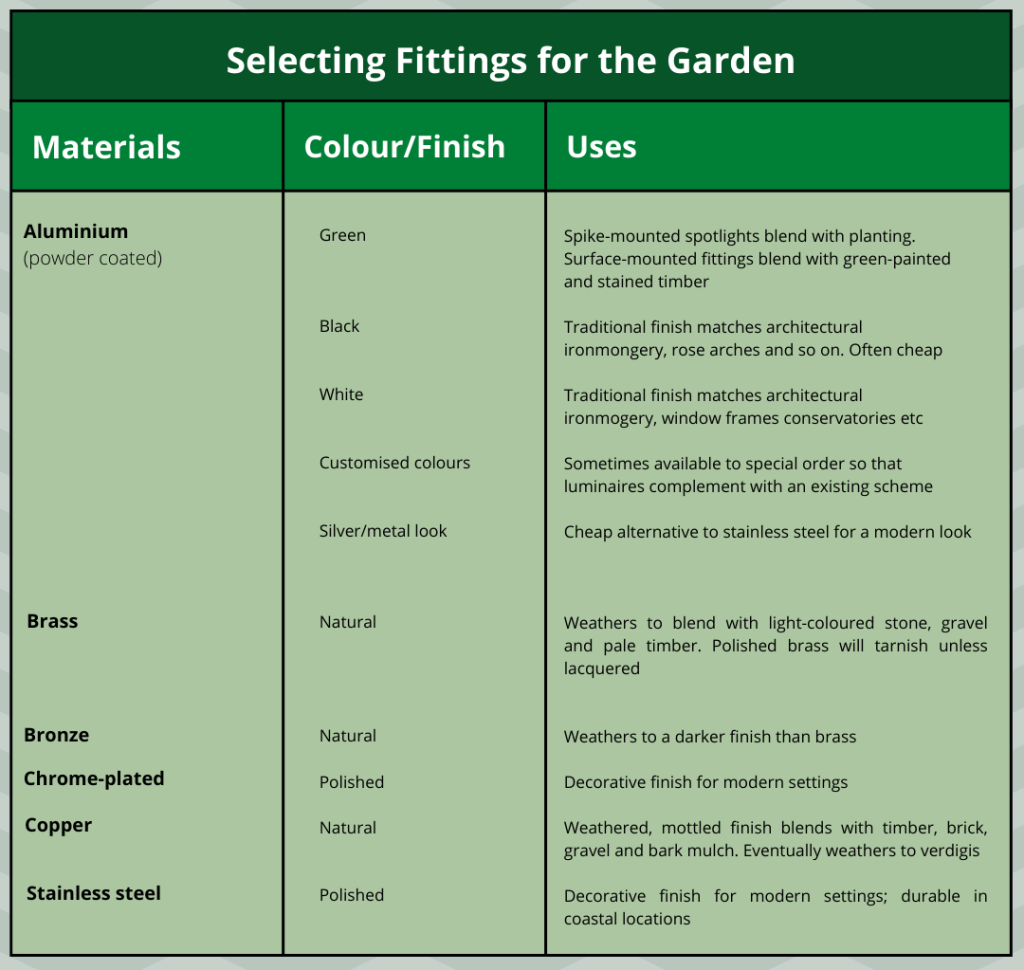Choosing the lights that will meet the needs of your garden lighting plan is one of the last and most significant steps in developing a lighting scheme. The products you select will be to taste and their size will complement the surroundings in terms of size and colour, whilst they’ll be reliable and easy to maintain.
Weatherproof or waterproof?
The first thing to think about is whether the luminaires must be weatherproof or waterproof. The two terms are different because waterproof concerns underwater lights where the lamp and electrical parts must be kept completely dry even when submerged in water. However, most lights won’t be used underwater so they’re okay to be weatherproof which will mean lamps are protected against splashes and trickles of water.
Dust and insects
The other elements that must be guarded against are more solid. Dust blowing into a luminaire will necessitate more frequent cleaning, and insect nests may result in a build-up of material that can cause a circuit breaker to trip out.
IP ratings
Each light is rated according to their resistance to the ingress of both liquids and solids by a code of defining their Index of Protection – often known as an IP rating – which you can usually find in the product catalogue or specification. Read more about IP ratings here.
Surface or recessed lights?
Recessed uplights are often chosen because burying the luminaire in the ground seems the best way to uplight a subject without the light source being visible. Uplighting a tree growing out of a lawn with a flush recessed uplight will allow mowing to be carried out without the risk of damaging the luminaire or creating a trip hazard, which would occur with a spike-mounted uplight in the same place.
In any open area, whether gravel decking or paving, a neatly recessed luminaire will always be preferable for unobtrusive lighting. In other positions, however, a spike-mounted spotlight may be more flexible and less expensive, provided it can be hidden among low planting, so it does not become a focal point in of itself.
Finishes and materials
The best garden lighting will be made from durable materials – aluminium, copper, brass, and stainless steel. Such materials can dissipate heat so that luminaires do not overheat and cause premature lamp failure or distortion of the luminaire body. Good heat dissipation means lower lens and body temperatures, which is beneficial when there’s accidental contact with the skin.
The finish may be a natural one for some metals, bare or polished form, or an applied colour, which is usually a powder coat rather than a liquid paint finish, as a well-applied powder coat is more durable. Different finishes are best suited to particular applications and locations, and these are summarised below.

Selecting light fittings
For the most commonly used types of garden-lighting products there are numerous key points that will make the lighting scheme more aesthetic or durable if the appropriate product choice is made.
Spike-mounted uplights and spotlights: Spike-mounted uplights are the workhouses of most garden-lighting schemes because ground-mounted uplighting is the most common choice for lighting trees, shrubs, columns, and focal points. Spike-mounted fixtures are the usual first choice because they can be adjusted more than recessed fittings and are typically more affordable.
Recessed uplights: Internal adjustability of the lamp housing is the main requirement if a recessed uplight is to be used to light one side of the vertical, so check that adjustability is possible – usually up to 15-20 degrees with side of the vertical. Where the location is a route for pedestrians or traffic, a grid accessory over the top of the luminaire will prevent any accidental damaging to the luminaire.
Underwater lights: All underwater lights, which must be rated at IP68 at least, should be equipped with a robust bracket with screw-locking adjustment so the luminaire’s focus can be maintained even in swirling water. The light will usually be fixed to an underwater block to anchor it in place, and all fixings must either be stainless steel or brass to be corrosion-proof.
Spreadlights: Spreadlights highly visible in the garden because it needs to stand to a given height to spread a pool of light around it. Cast-aluminium alternatives are preferable where children are likely to test the strength of the fittings, and these are available in a variety of colours to blend with the background or to march other garden hardware.
At Lighting for Gardens, we have a full collection of high-quality market leading Elipta lighting products. Explore the range to see professional lighting products for all your outdoor lighting needs.